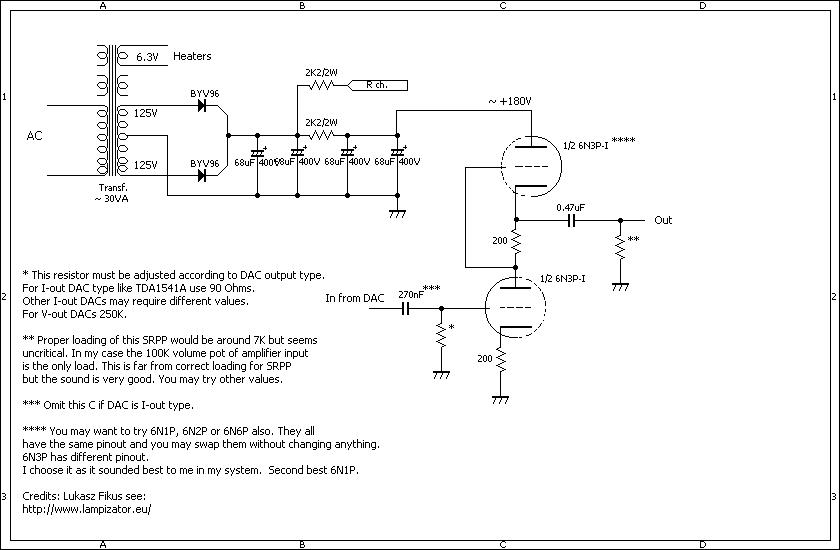The Lampizator Experience
Modifying HIFI system components to achive better performance is also a soft spot of mine. Around and in the CD player there is quite a number of things that can be done like building a base that decouples it from vibrations, damping the chassis, changing the caps and rectifier diodes in the power supply, changing the output OPA for faster ones and biasing them into class A operation. Sure all the above can help improve the CD player performance, specially with the last two mentioned I had very positive results. But the best was yet to come. After I got into tubes I wanted to try a tube output stage that would replace all that circuitry behind the DAC in the CDP. Lack of knowledge, time and space held me away from this until I came across Lukas Fikus web pages about the Lampizator.

Lukas Fikus explains how to build and connect a tube output stage to a CD player in a very
keen way. All analog anti aliasing filter is skipped while the tube output stage interfaces
directly to the CDP's DAC. In most cases the tube output stage is based on an SRPP topology.
There are different opinions about this practise. Some argue that the HF noise can upset the circuits that follow in the line or power amplifier or even the speakers. Also this HF noise may cause intermodulation distortion by mixing with the wanted audio signal. Others say the HF noise and spectral audio components are so far away from the human audible range that they don't matter at all. Be it as it may the best way is to find out by oneself and I was curious enough to do it.
I had just finished my first 2A3 SE amp when I got to know Lukas Fikus' site. The driver of the 2A3 SE amplifier was an SRPP circuit, just as Lukas Fikus proposes for Lampizator. Thus all that was needed was a plain DAC output to interface to the amplifier.
A PC CD-ROM drive that featured a play button was at hand to try this out. It took me a long while to find the DAC output. Via 220nF MKP capacitor, each CD-ROM DAC output was connected straight to the input of the 2A3 SE amplifier.


Much to my surprise and perplexity it turned out that the CD-ROM sounded better to me than
my Rotel RDC-1072. I had 'tuned' the Rotel long before by exchanging the original OPAs after
the DAC for BB OPA2604 biased into class-A. The Rotel has a 24 bit sigma-delta DAC, the
BB PCM1732. The CD-ROM features a TOSHIBA DAC, also 24 bit sigma-delta type. Fortunately with high
enough output voltage swing to drive the 2A3 amp directly.
The setup with the CD-ROM drive was very much against common 'high-end practise': CD-ROM drives
contain lots of HF noise, the power supply for it was a switched mode laptop type (more noise) and
last not least the analog signal was taken directly from the DAC bypassing any antialiasing filter,
even more noise! Yet the sound from this setup appeared to me to be more fluid and smoother, more
exiting more lively.
I kept this CD-ROM setup for several weeks until I had a Philips CDP featuring the renowned TDA1541 DAC.
I modified it in the Lampizator fashion using 6N1P tubes in SRPP mode and modified it also to non
oversamplig mode. This Philips CD-830 now outperformed the CD-ROM setup being more musical and featuring
also a stronger bass (I think this is due to the DAC being a R-2-R type rather than a sigma-delta).
This result made me try and do the same for the Rotel CDP so an external Lampizator was build for it.
See the first picture on this page.
There are a lot of screws to be removed to open the Rotel CDP.
Locating the DAC inside the Rotel is easy. The L and R outputs go straight to an electrolitic capacitor before the
signal is fed to the LPF and buffer OPA. After the OPA another electrolitic decouples the output
before the signal goes to the RCA. I removed the 4 capacitors, took a HQ MKP with 470nF and soldered
one end to the PCB at the point where the output C leads to the RCA. The other end of the 470nF connects
to the DAC output. This way the DAC output is available at the RCA connectors of the CDP and can easily
be taken to interface to CDPs external Lampizator. I will try to provide a picture sometime ...
The Rotel sounds so much better than before. Clearer, more 'fluid' with a stronger bass, better stage
and detail. It further has the added value that the output signal level is high enough to directly
interface to the 2A3 SE amplifier. The schematic is quite simple and the realisation as well.

Today, after knowing the virtues of the Aikido circuit I would rather interface the CDP DAC directly to an Aikido than to an SRPP circuit. I have not bothered because the DAC Magic is doing a marvelous job and I have been busy building the Aikido 2A3 SE Amplifier.